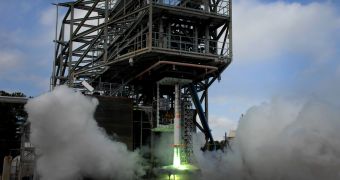Engineers at the NASA Marshall Space Flight Center (MSFC), in Huntsville, Alabama, have recently begun conducting a series of acoustic tests on a scale model of the Space Launch System, the super-heavy rocket that the American space agency is developing for sending astronauts beyond Earth's orbit.
The first round of acoustic tests began in Alabama on January 16, and targeted the sound suppression systems being developed for the SLS. Engineers have mostly focused their efforts on the low- and high-frequency sound waves that the rocket will produce during the early stages of launch.
The first SLS rocket is scheduled to conduct a test flight no earlier than 2017. This will not be the super-heavy version of the Space Launch System, but rather a heavy variant, meant to provide flight engineers with all the data they need to scale up the design.
This delivery system is the most ambitious project NASA has undertaken in rocket development since the Saturn V, the launcher used throughout the Apollo program. The largest SLS will be able to ferry more cargo into low-Earth orbit (LEO) than the Saturn V, though its record-breaking capabilities may soon be exceeded by those of a yet-unnamed Russian launcher.
NASA engineers at Marshall say that the recent tests provided them with a wealth of data on how the rocket and the potential crew aboard the SLS will be affected by the massive roar of the engines. The SLS is being developed to carry the Orion Multi-Purpose Crew Vehicle (MPCV) manned capsule.
“We can verify the launch environments the SLS vehicle was designed around and determine the effectiveness of the sound suppression systems. Scale model testing on the space shuttle was very comparable to what actually happened to the vehicle at liftoff,” says the technical leader of the acoustic testing sessions, MSFC expert Doug Counter.
The main component of the future SLS sound suppression system will be water. The rocket will launch from the Kennedy Space Center, in Florida, where some launch pads are outfitted with rainbirds capable of releasing as much as 450,000 gallons (1.7 million liters) of water shortly before launch.
Rainbirds are massive water nozzles installed on the mobile launch platform used at KSC to ferry rockets from the Vehicle Assembly Building (VAB) to one of the two launch pads. This is why SLS engineers are conducting tests in Florida already, as well as at the University of Texas at Austin.

 14 DAY TRIAL //
14 DAY TRIAL //